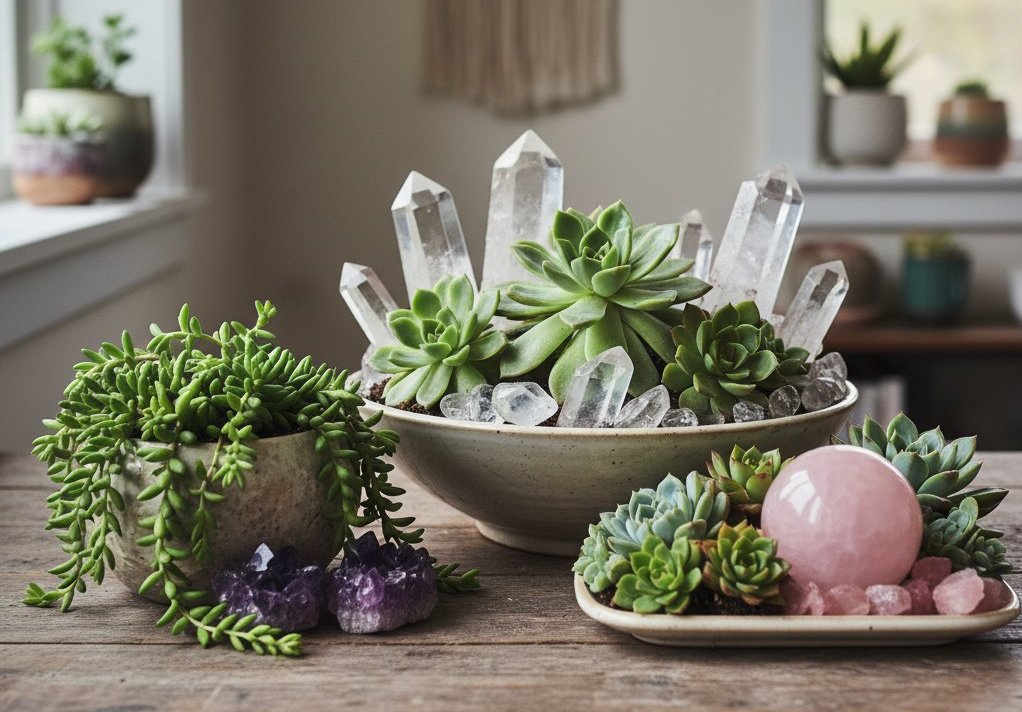Succulent Arrangements With Crystals
Succulent arrangements with crystals combine natural texture and subtle color to create displays that feel balanced and calming. You can design one as a centerpiece, a small desk accent, or a gift that lasts with minimal care. A succulent crystal arrangement blends the resilience of plants with the reflective beauty of stones, bringing harmony to both your space and your routine.
You’ll explore how to pair succulents and crystals that complement each other in shape and tone. Simple design choices, like grouping soft green rosettes around clear quartz or placing amethyst near trailing varieties, can turn an ordinary planter into a thoughtful display.
By learning how to select materials, arrange them with intention, and care for them over time, you can create a living piece that reflects your style and supports a calm environment.
What Are Succulent Arrangements With Crystals?
Succulent arrangements with crystals combine living plants and natural stones to create decorative displays that balance texture, color, and form. You can use them to enhance indoor décor, add visual interest to tabletops, or design a small succulent garden that reflects your personal style.
Defining Succulent Arrangements
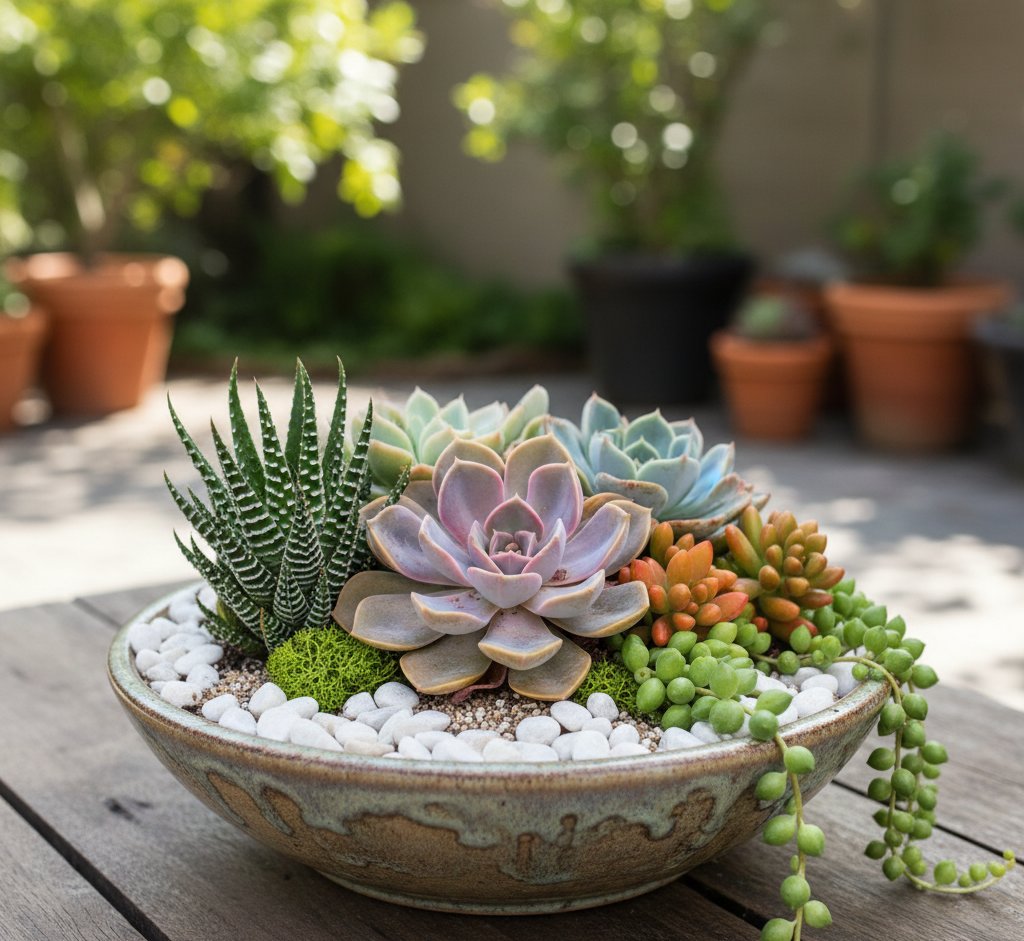
A succulent arrangement is a collection of drought-tolerant plants arranged in a single container or display. These plants store water in their leaves and stems, making them easy to maintain.
You can use planters, bowls, or shallow trays to group different species such as Echeveria, Sedum, or Haworthia. Varying shapes and colors help create contrast and depth.
Good arrangements balance spacing so each plant has room to grow. Adding pebbles, sand, or decorative moss around the base helps with drainage and gives a clean, finished look. Whether indoors or outdoors, these displays thrive in bright, indirect light and well-draining soil.
The Role of Crystals in Plant Displays
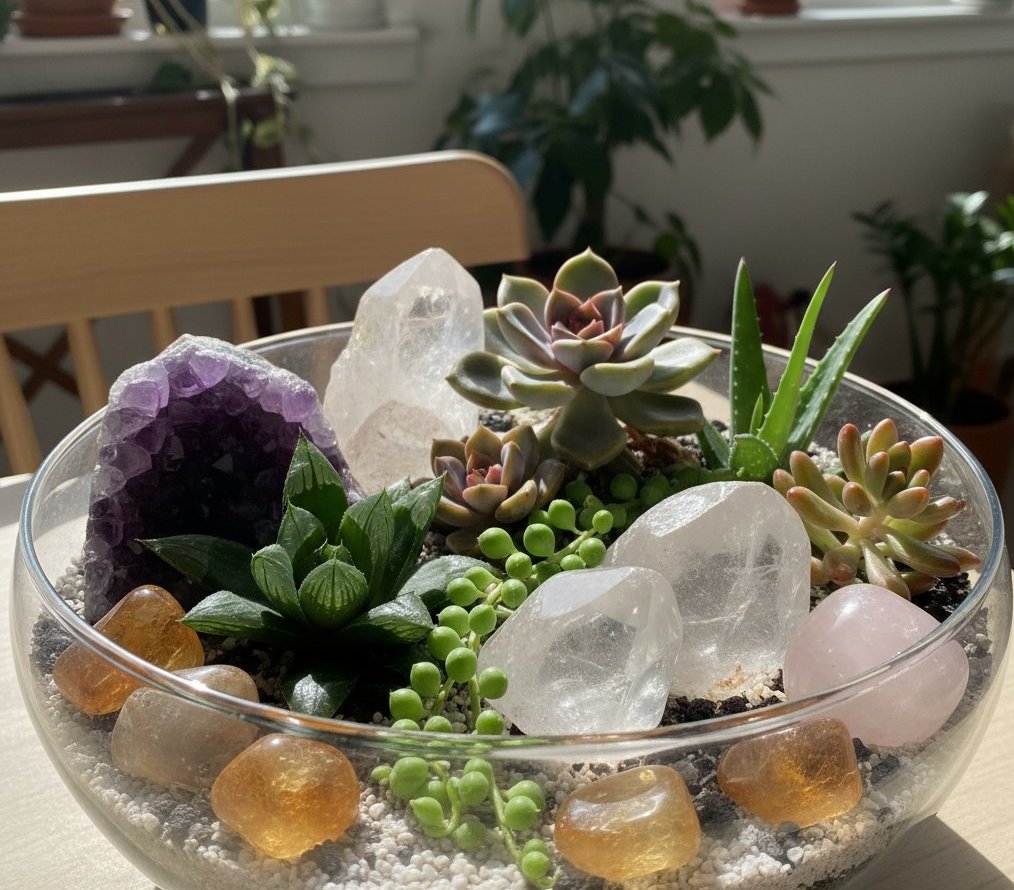
Crystals serve both decorative and symbolic roles in succulent displays. Their textures and colors, like the clear tones of quartz or the soft pink of rose quartz, complement the natural greens and blues of succulents.
You can place crystals between plants, along the edges of pots, or as a central feature. Some people choose stones for their aesthetic harmony, while others value their associations with calmness or positive energy.
Common stones include:
| Crystal | Visual Effect | Common Use |
|---|---|---|
| Clear Quartz | Bright, reflective | Enhances light and clarity |
| Amethyst | Soft purple tone | Adds contrast and depth |
| Citrine | Warm yellow hue | Brings color to neutral displays |
Using crystals also reduces soil displacement and helps anchor smaller succulents in shallow containers.
Popular Trends in Succulent and Crystal Pairings
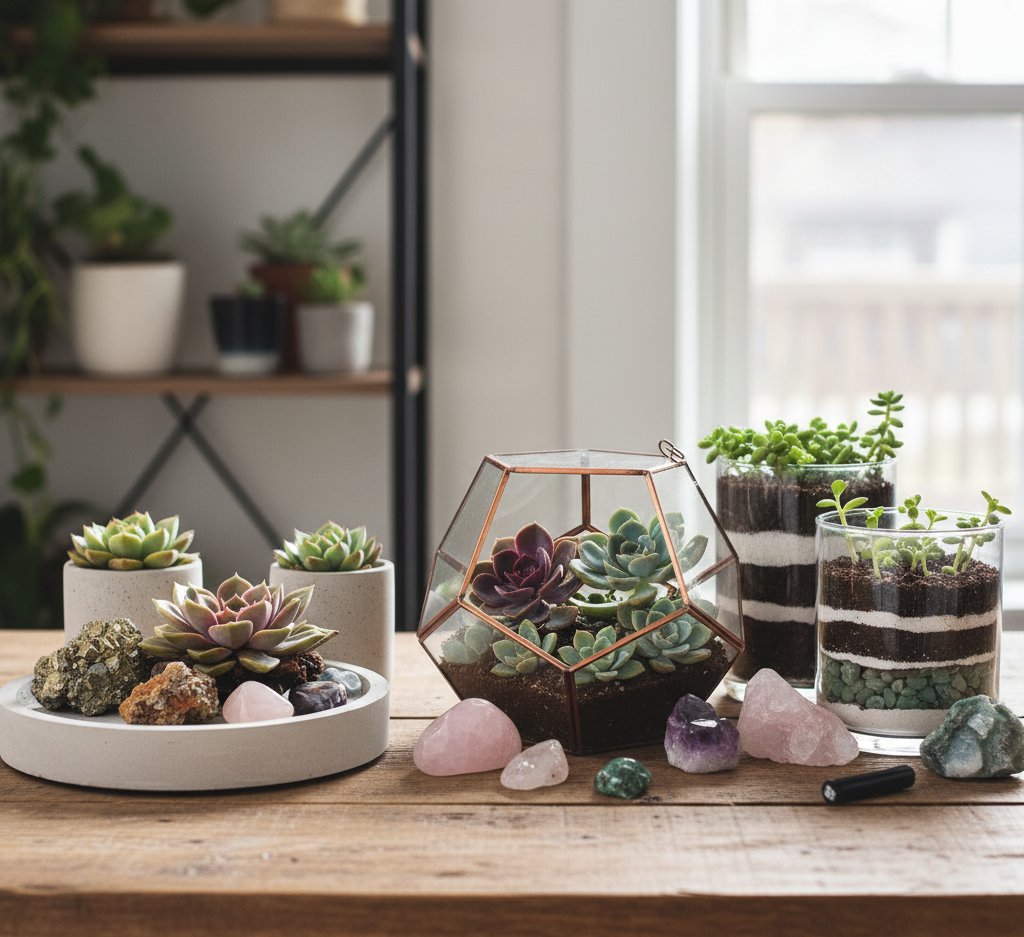
Modern designs often pair geometric containers with polished stones for a clean, minimalist style. You might also see raw mineral clusters used in natural or bohemian themes.
Miniature succulent gardens often include quartz points or tumbled stones arranged like small landscapes. Some creators use layered terrariums with sand, soil, and crystals stacked in visible layers.
On platforms like Pinterest and Etsy, handmade arrangements combine crystals with hardy succulents for personalized gifts or décor pieces. These displays highlight natural beauty while staying low maintenance and adaptable to many spaces.
Choosing the Right Succulents and Crystals
Select plants that share similar light and water needs, and pair them with crystals that complement their natural forms and colors. Focus on combinations that balance appearance, texture, and care requirements to create stable, healthy arrangements.
Best Succulent Varieties for Arrangements
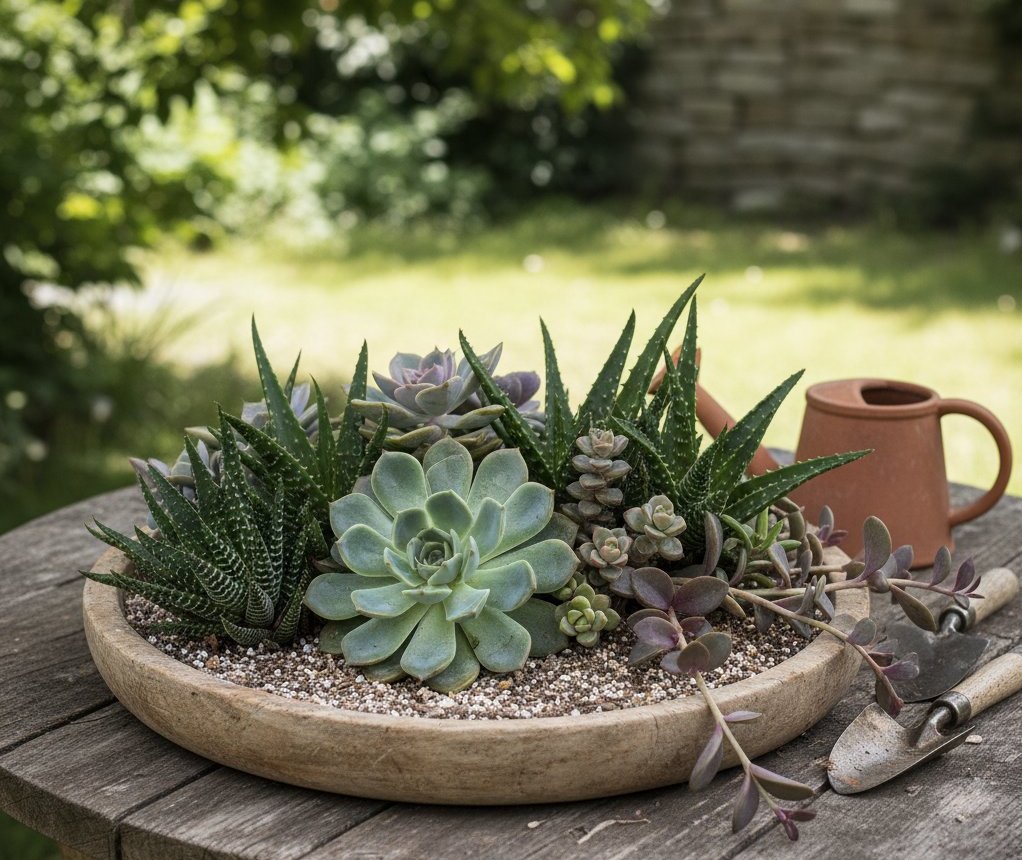
Choose succulents that stay compact and adapt well to container growth. Echeveria, Haworthia, and Graptopetalum are popular because they maintain neat rosette shapes and come in diverse colors. Their slow growth helps preserve arrangement balance over time.
Mixing textures adds visual depth. Pair smooth-leaved species like Echeveria elegans with spiky forms such as Aloe juvenna or geometrically-stacked Crassula perforata. This contrast keeps the design interesting without overcrowding the container.
Use a well-draining soil mix and ensure consistent light exposure. Group plants with similar needs, most succulents prefer bright, indirect sunlight and infrequent watering. Avoid combining moisture-loving species with drought-tolerant ones, as that can lead to uneven growth or root rot.
Selecting Complementary Crystals
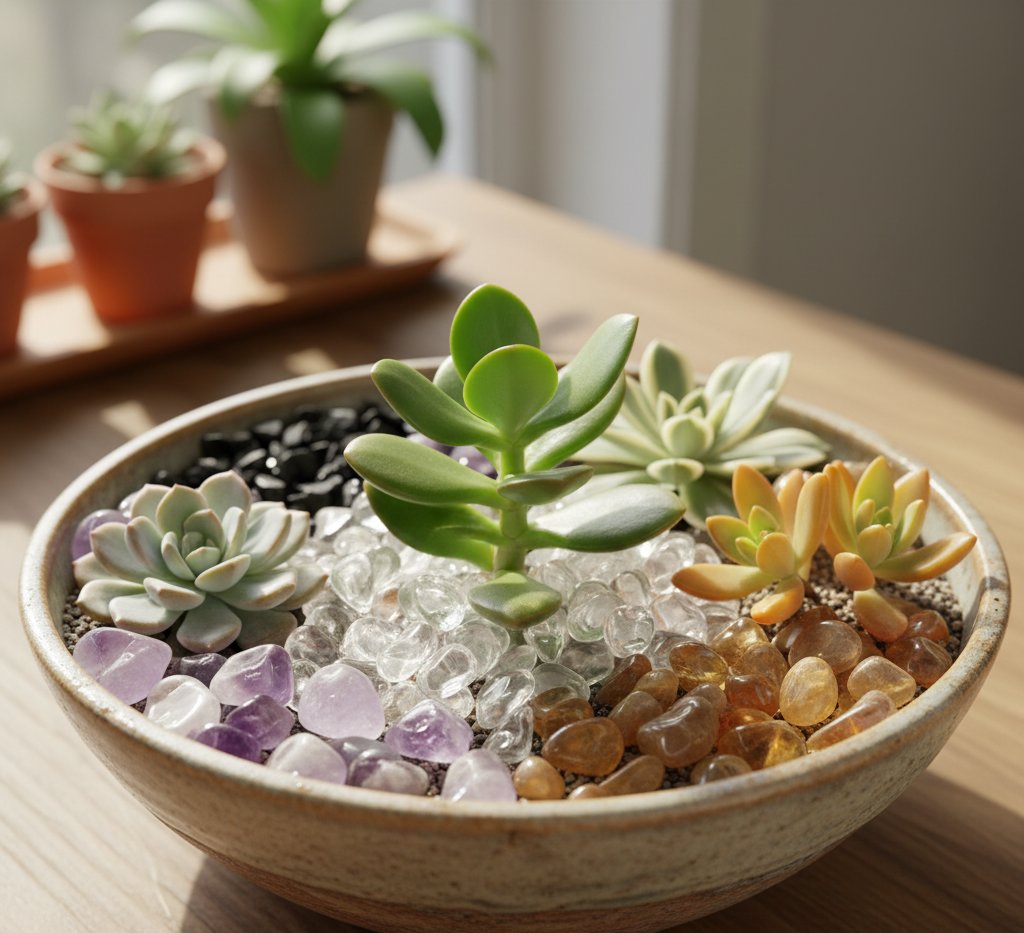
Crystals can enhance the visual appeal of your arrangement. Choose stones that match your plants’ tones and textures rather than relying on symbolic meanings.
| Crystal | Appearance | Works Well With |
|---|---|---|
| Clear Quartz | Transparent, reflective | Bright green succulents like Jade Plant |
| Amethyst | Purple hues | Pale or gray succulents such as Echeveria lilacina |
| Citrine | Warm yellow | Orange-tinged species like Sedum adolphii |
| Black Tourmaline | Deep black | Light-colored or variegated succulents |
Use small tumbled stones or chips around the base of plants. Keep them clean and avoid blocking airflow or water drainage. Natural stones are best, as synthetic ones may fade or leach color into the soil.
Sedums in Mixed Displays
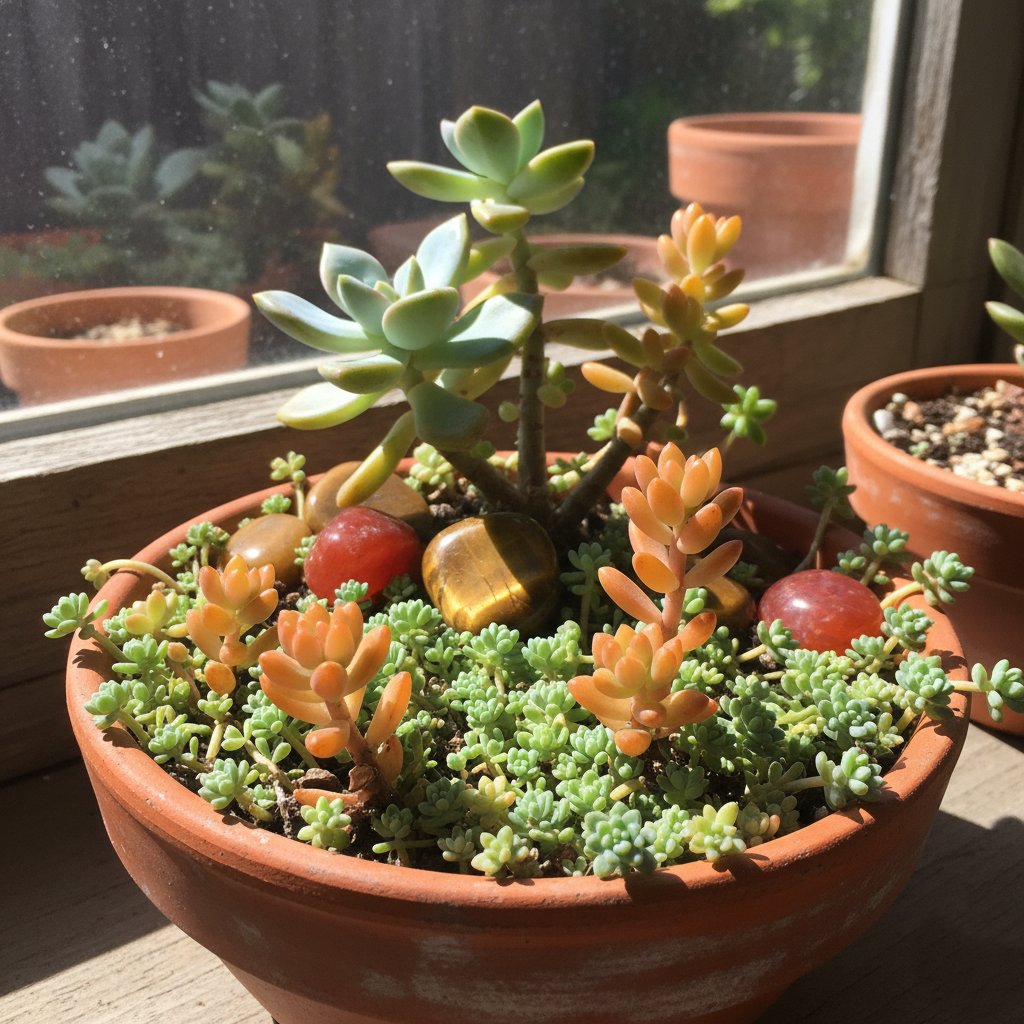
Sedums add flexibility and texture to mixed succulent arrangements. Their trailing or mat-forming habits fill gaps and soften edges around taller plants like Echeveria or Crassula.
Low-growing types such as Sedum dasyphyllum or Sedum rubrotinctum create a living carpet over soil, helping retain moisture while preventing erosion. In contrast, upright forms like Sedum nussbaumerianum add height and warm tones that pair well with neutral-colored crystals.
Because sedums tolerate full sun and dry conditions, they suit outdoor displays and windowsills. Combine them with stones like Tiger’s Eye or Carnelian, which visually echo their golden and red hues, creating a cohesive and balanced look.
Design Principles for Succulent Arrangements With Crystals
A well-designed succulent arrangement depends on how you combine plant colors, textures, and heights with the shapes and tones of crystals. Paying attention to balance, spacing, and material contrast helps you create a display that looks natural yet intentional.
Balancing Color and Texture
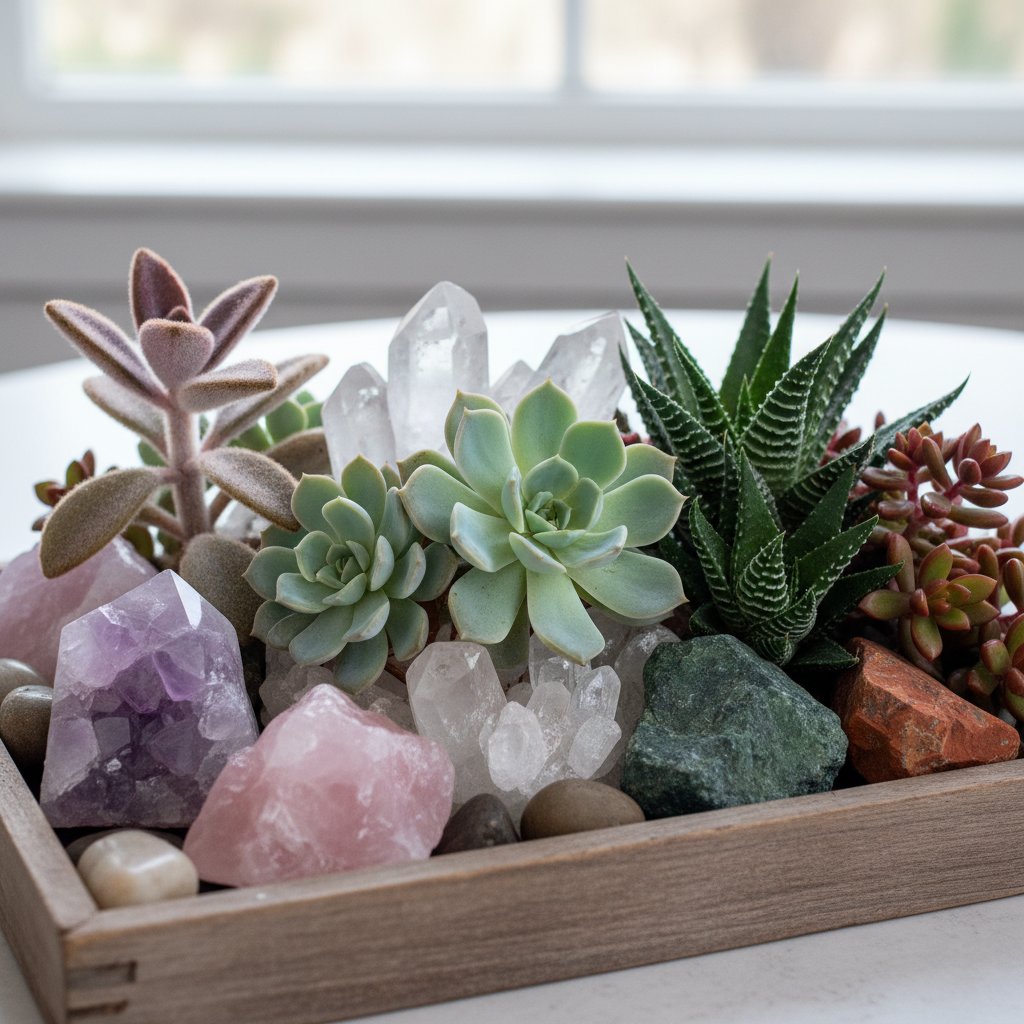
When building your succulent display, choose plants and crystals that complement each other in both color and surface texture. Soft greens, muted purples, and silvery blues pair well with clear or rose quartz, while deeper greens and reds look striking next to darker stones like jasper or aventurine.
Mix succulents with different leaf textures, smooth echeverias beside fuzzy kalanchoes or spiky haworthias. The contrast keeps the display from looking flat.
Use the following quick guide for pairing tones:
| Plant Color | Crystal Type | Effect |
|---|---|---|
| Pale green or gray | Clear Quartz | Clean and bright look |
| Pink or purple | Amethyst | Soft, calm tone |
| Deep green | Citrine or Jasper | Warm, grounding feel |
Avoid using too many shiny or polished stones together. Mixing raw and polished pieces gives a more natural balance.
Creating Visual Interest With Heights and Shapes
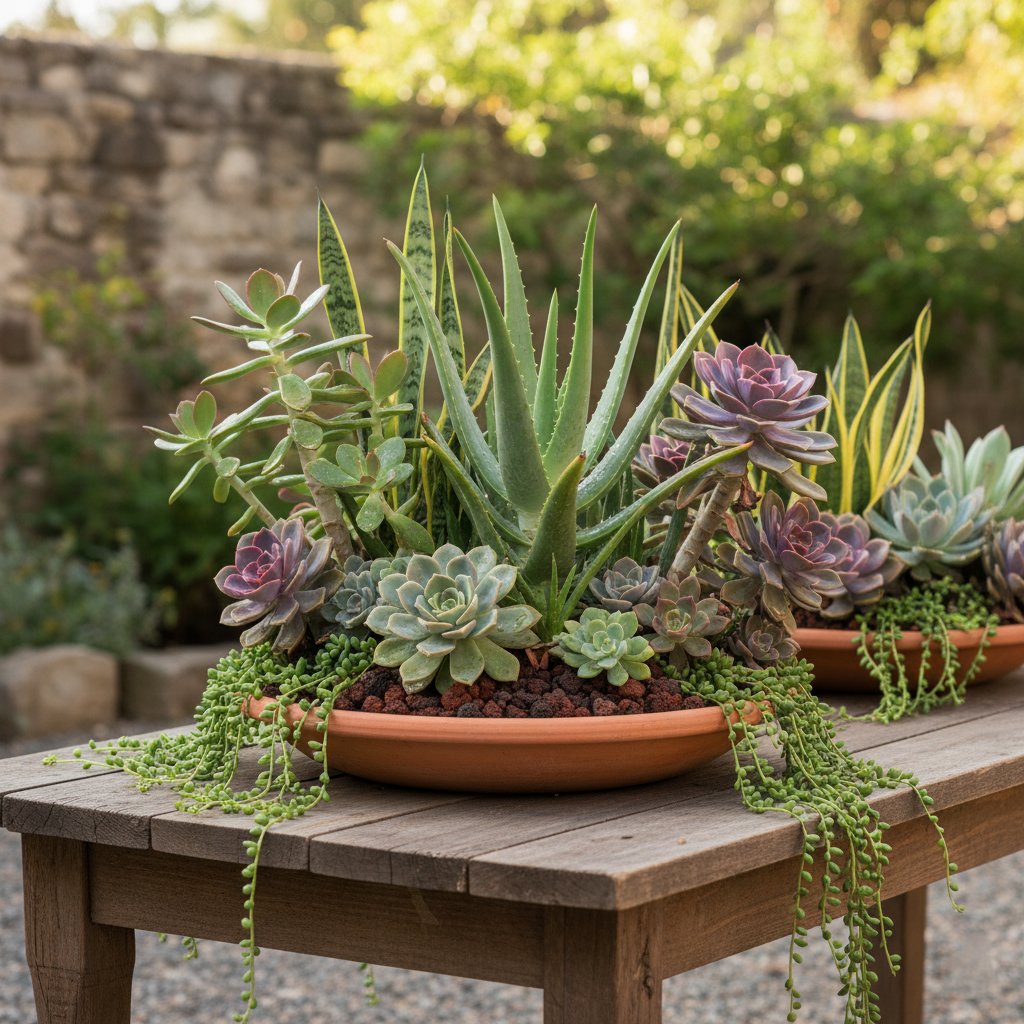
Arrange your succulents so the tallest plants form a center or back focal point, depending on whether the display is viewed from one side or all around. Place medium and low-growing plants in front or around the edges to create a layered look.
Vary shapes to keep the eye moving. Combine rosette forms, trailing stems, and upright columns. For example, tall aloe or jade plants can anchor the center, while string succulents or sedums soften the edges.
Leave adequate spacing for air circulation and future growth, which prevents fungal issues and overcrowding while still highlighting individual plants.
Incorporating Crystals for Aesthetic Appeal
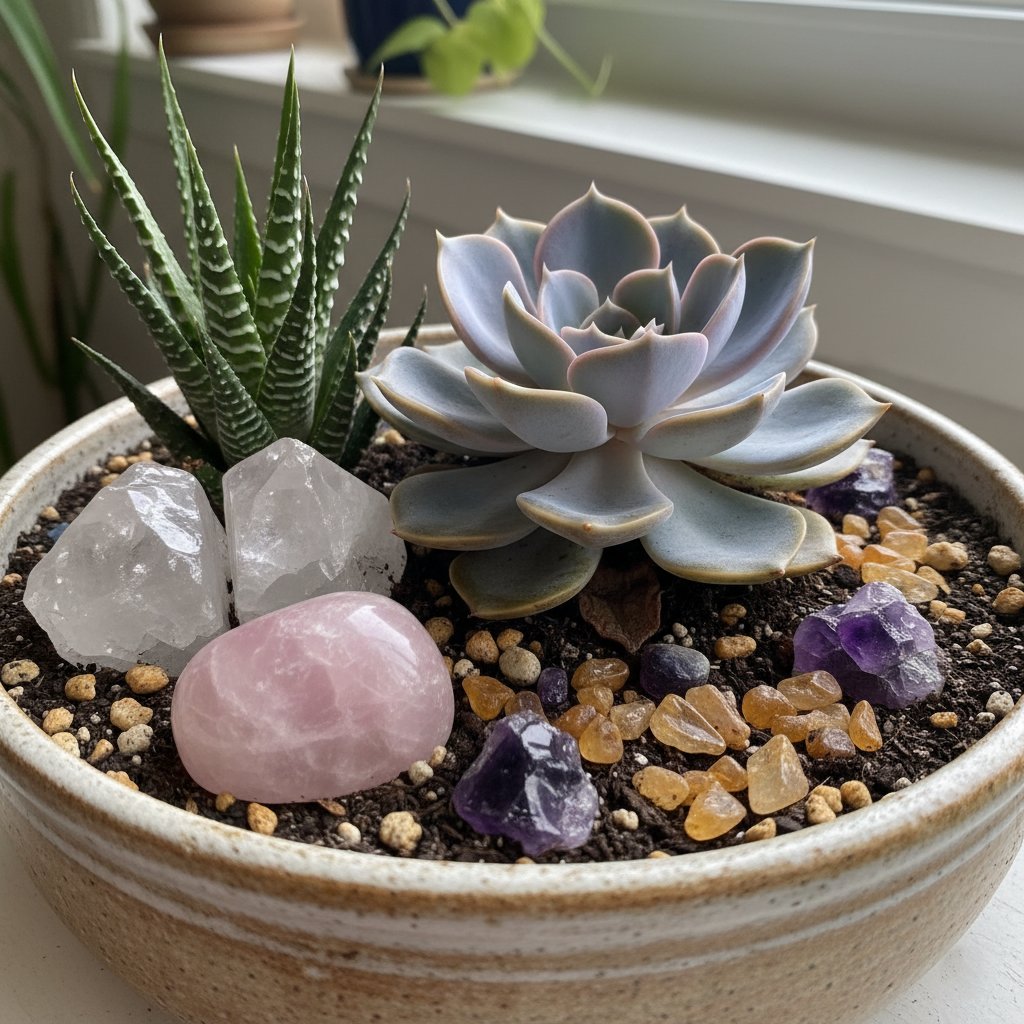
Crystals serve as both decorative and structural elements. Place larger stones near the base of tall succulents to stabilize the visual weight. Smaller pieces can fill gaps or frame clusters of plants.
Use crystals with natural tones that blend with soil and top dressing. Clear quartz and rose quartz reflect light gently, while rough stones like amethyst or citrine add texture.
Position crystals where they catch light but don’t overshadow the plants. A few well-placed stones create harmony and draw attention to your arrangement’s focal points without making it look cluttered.
Step-By-Step Guide to Creating Your Arrangement
You’ll build your display by preparing a clean container, placing healthy succulents, and positioning crystals to balance color and texture. Each step focuses on stability, airflow, and natural harmony between the plants and stones.
Preparing Your Succulent Container
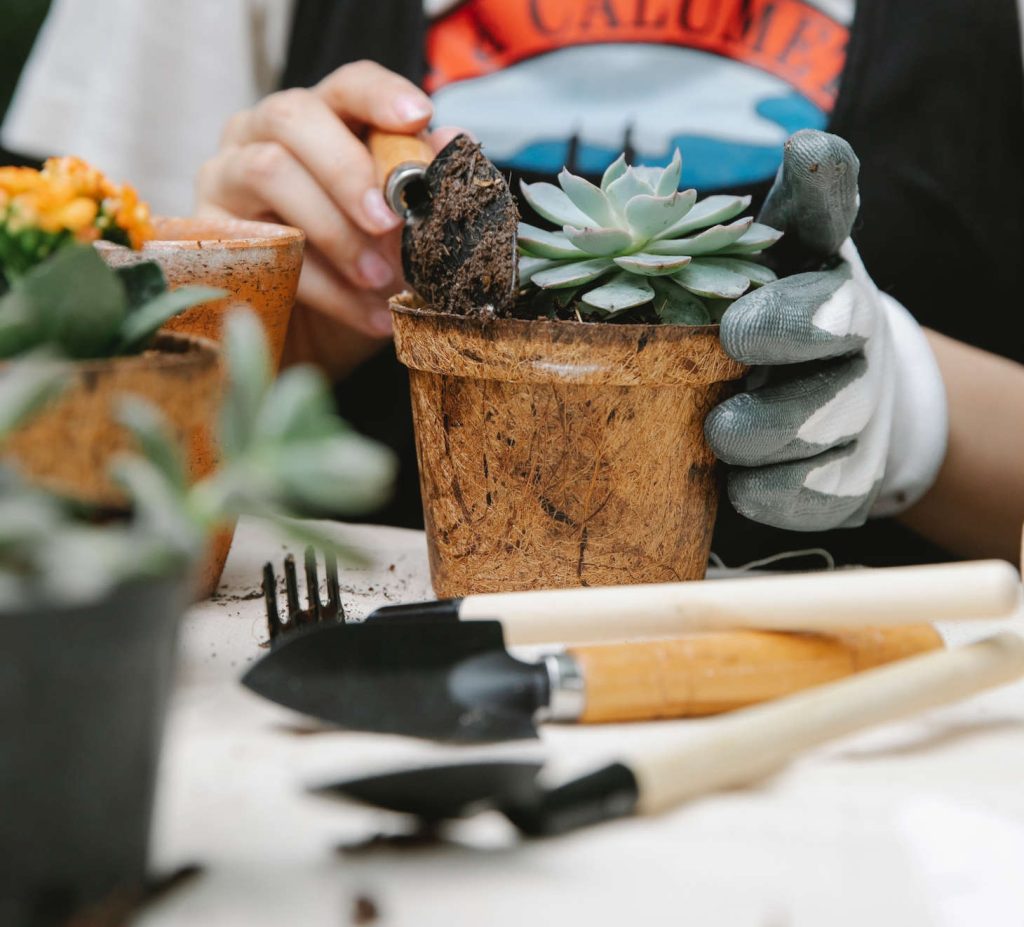
Choose a container with a drainage hole to prevent root rot. Shallow ceramic or terracotta bowls work well because they dry quickly and keep roots healthy. Avoid glass containers without drainage unless you plan to water very sparingly.
Fill the container with a succulent soil mix. This soil drains fast and reduces moisture buildup.
Before planting, arrange your materials on a flat surface. Keep your succulents, crystals, and tools, such as a spoon or small tongs, within reach. Lightly moisten the soil so it’s easier to work with but not wet.
If you’re reusing a container, clean it with mild soap and water. Rinse and dry completely to remove any residue that could harm the plants.
Arranging Succulents and Crystals
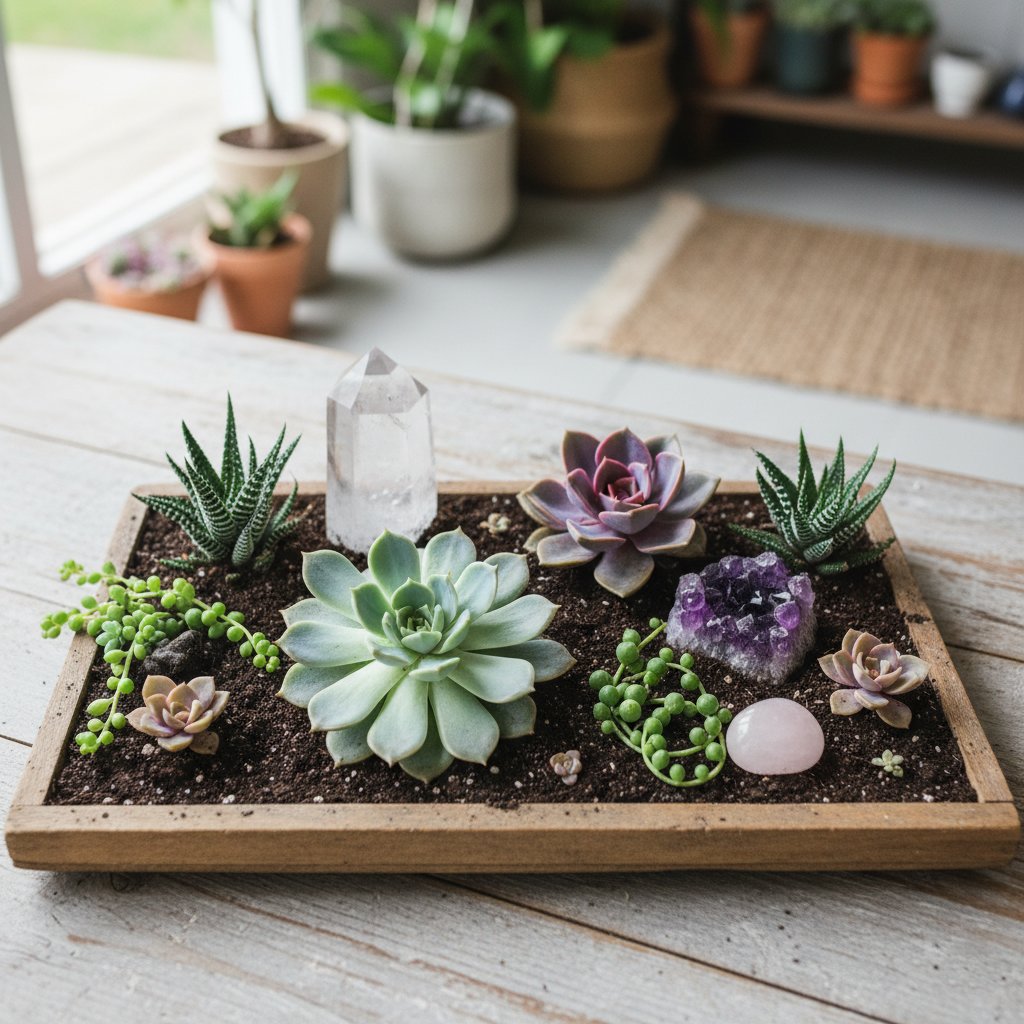
Start by placing the largest succulents first. Position them slightly off-center for a natural look. Add medium and small plants around them. Succulents can be planted close together for a full, long-lasting arrangement, or spaced slightly (e.g., 1/2 to 1 inch apart) to allow for faster growth.
Once the plants are in place, gently press the soil around each base to stabilize them. Avoid packing the soil too tightly.
Add crystals such as clear quartz, amethyst, or rose quartz between plants. Match stone colors with leaf tones for a balanced design. Keep crystals away from the stem area to prevent moisture from trapping underneath.
Finishing Touches and Placement Tips
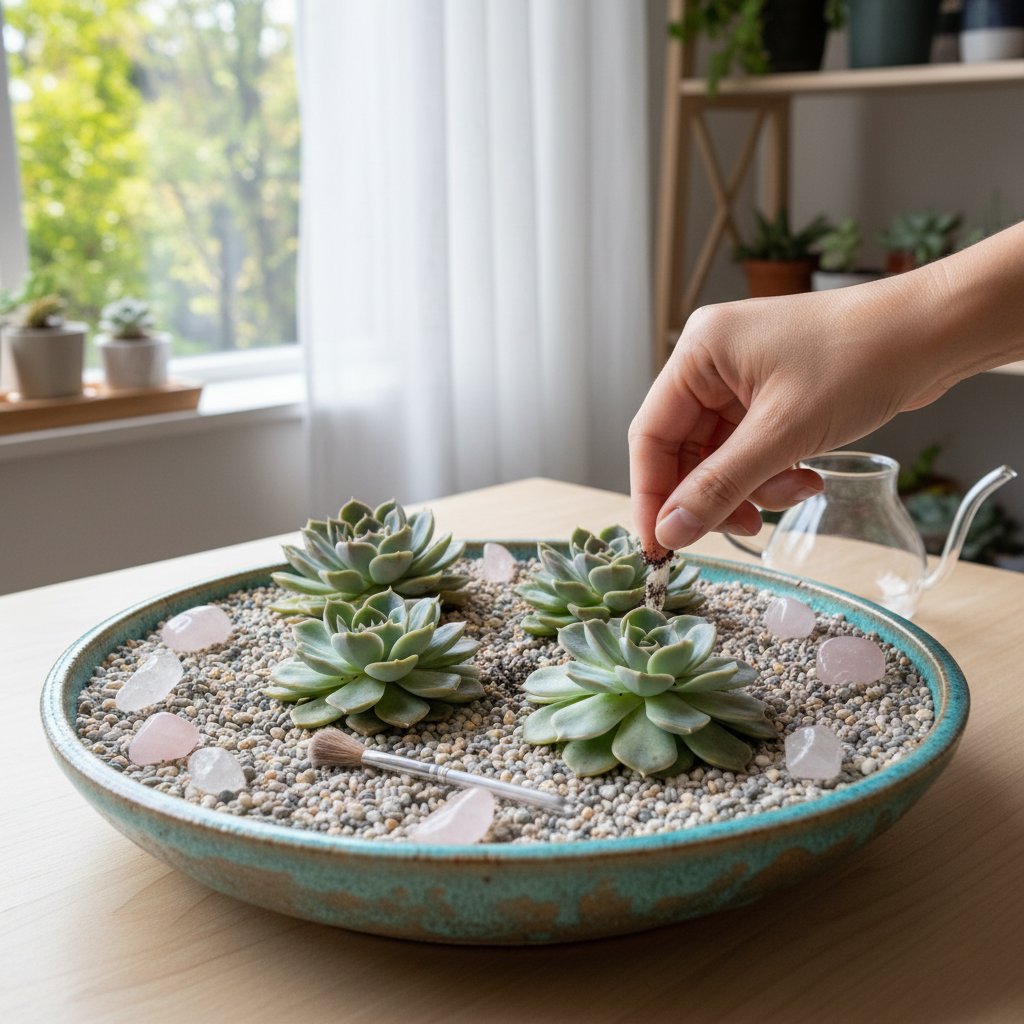
Top the soil with a thin layer of decorative gravel or sand to reduce evaporation and keep the surface tidy. You can also use small pebbles to frame crystals or define sections of the arrangement.
Wipe off any soil on leaves or stones with a soft brush. This small step makes your display look clean and well-kept.
Place the finished arrangement in a bright location with indirect sunlight. Succulents prefer about six hours of light daily. Rotate the container every few weeks so all sides get equal light exposure.
Water sparingly, only when the soil feels dry about an inch deep. Overwatering is the most common mistake in succulent arrangements, especially in decorative containers.
Creative Ideas and Inspiration for Succulent Crystal Displays
You can design eye-catching succulent displays by pairing natural crystals with plants that thrive in small containers. Focus on balance, texture, and light to create arrangements that look intentional and stay healthy over time.
Miniature Landscapes and Themes
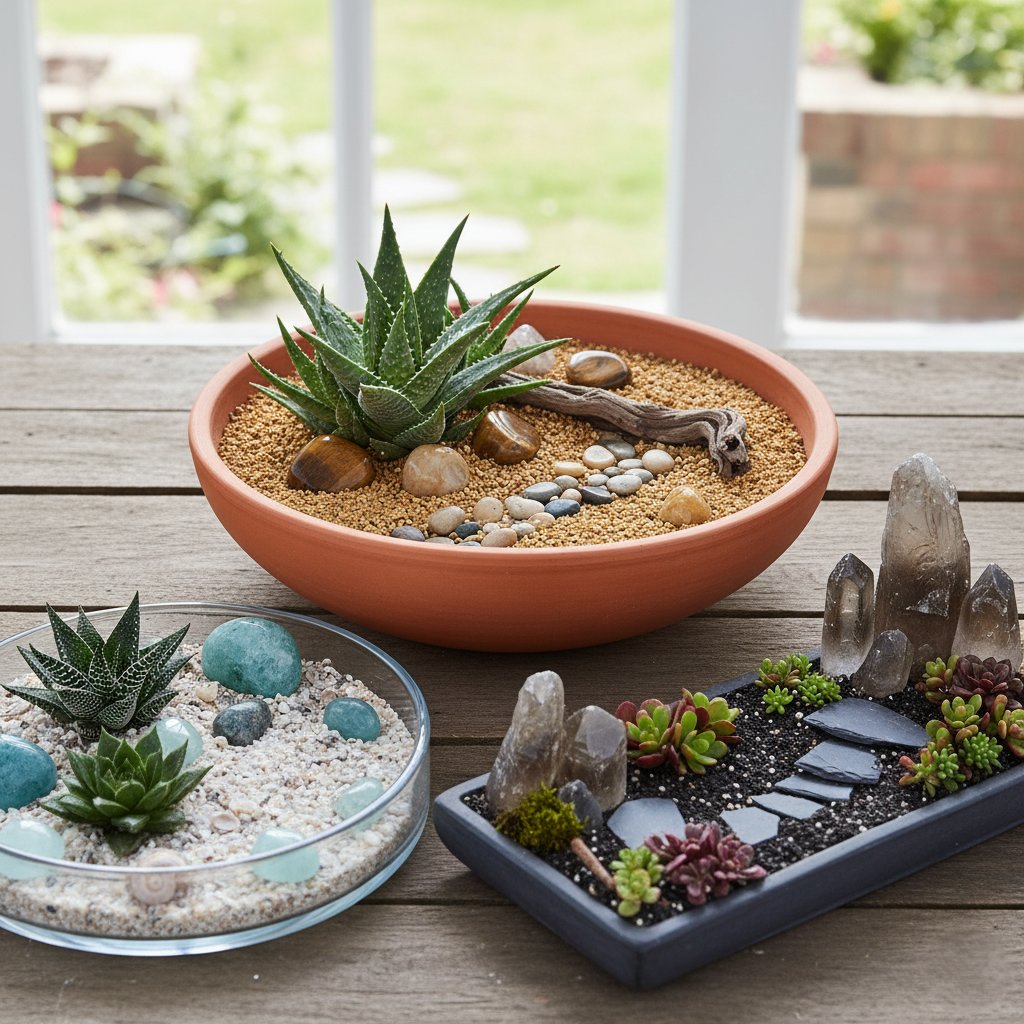
Build small scenes that tell a story. Combine succulents, crystals, and natural materials like sand, pebbles, or driftwood to create a miniature landscape. For example, mix clear quartz with pale echeveria for a calm, airy look, or use amethyst next to jade plants for deeper color contrast.
Try arranging plants and crystals by theme:
| Theme | Suggested Elements |
|---|---|
| Desert Oasis | Aloe, tiger’s eye, sandy soil |
| Coastal Scene | Haworthia, aquamarine, seashells |
| Mountain Garden | Sedum, smoky quartz, slate pieces |
Keep the scale consistent so the display looks cohesive. Use small containers or shallow trays to control spacing and prevent overcrowding.
Unique Container Options
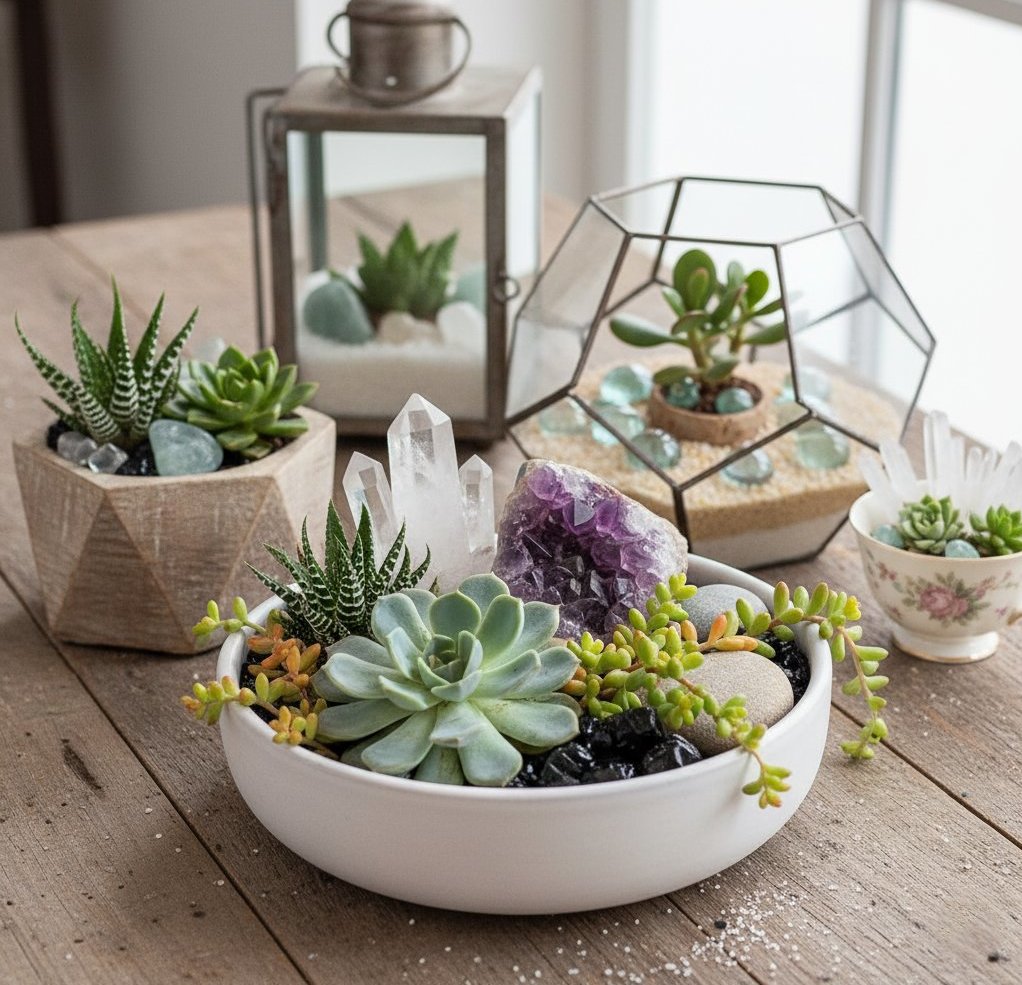
Choose containers that highlight both the succulent display and the crystals. Glass terrariums, ceramic bowls, and wooden boxes each create different effects. Transparent containers let light pass through crystals, while matte finishes emphasize texture and color.
You can repurpose items like teacups, lanterns, or small metal tins. These make compact succulent containers for desks or shelves.
If you prefer a modern style, use geometric planters with clean lines. For a rustic look, try aged clay pots or reclaimed wood boxes. The container should support healthy growth while matching your space’s style.
Seasonal and Gift Arrangements
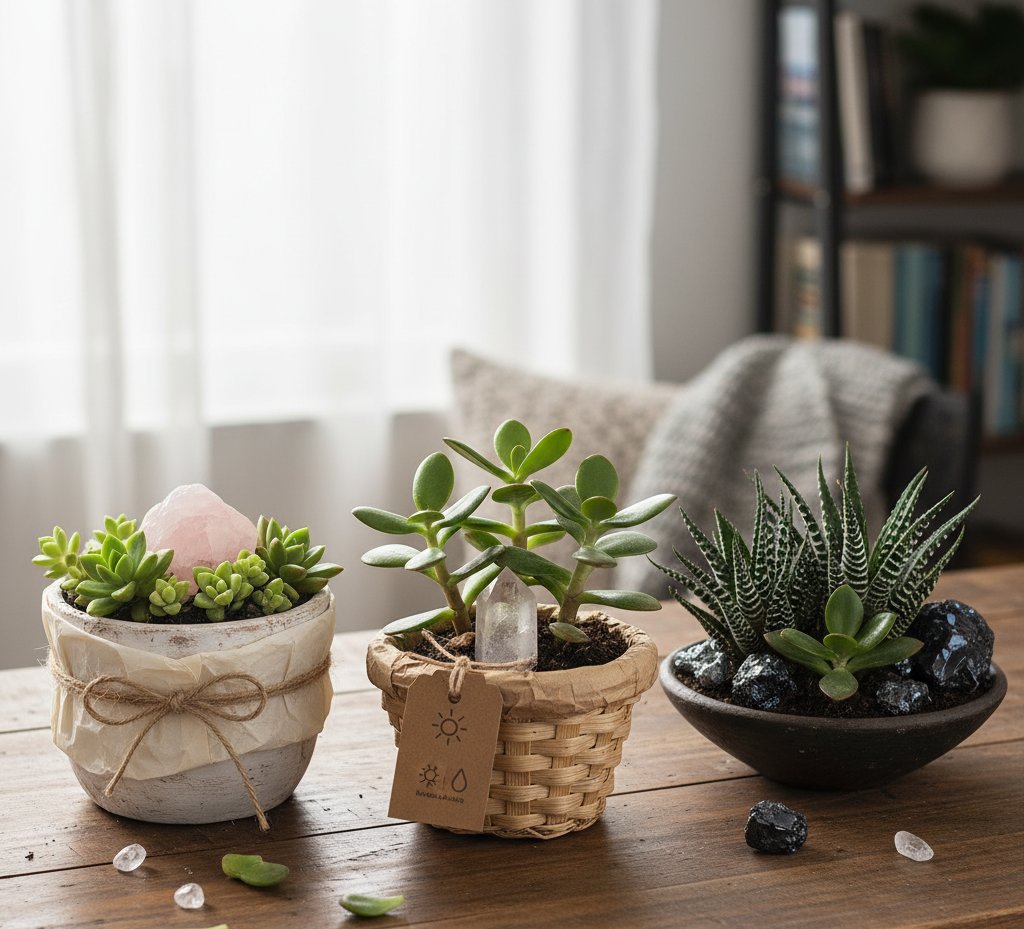
Adapt your succulent and crystal combinations for different occasions. In spring, use bright green succulents with rose quartz for a fresh, soft look. During winter, pair darker stones like obsidian or hematite with deep green haworthia for a simple, grounded design.
You can also create gift arrangements by grouping small succulents with a single crystal centerpiece. Wrap the container in kraft paper or place it in a small basket for presentation. Add a care tag with watering and light instructions to make the gift practical and easy to maintain.

